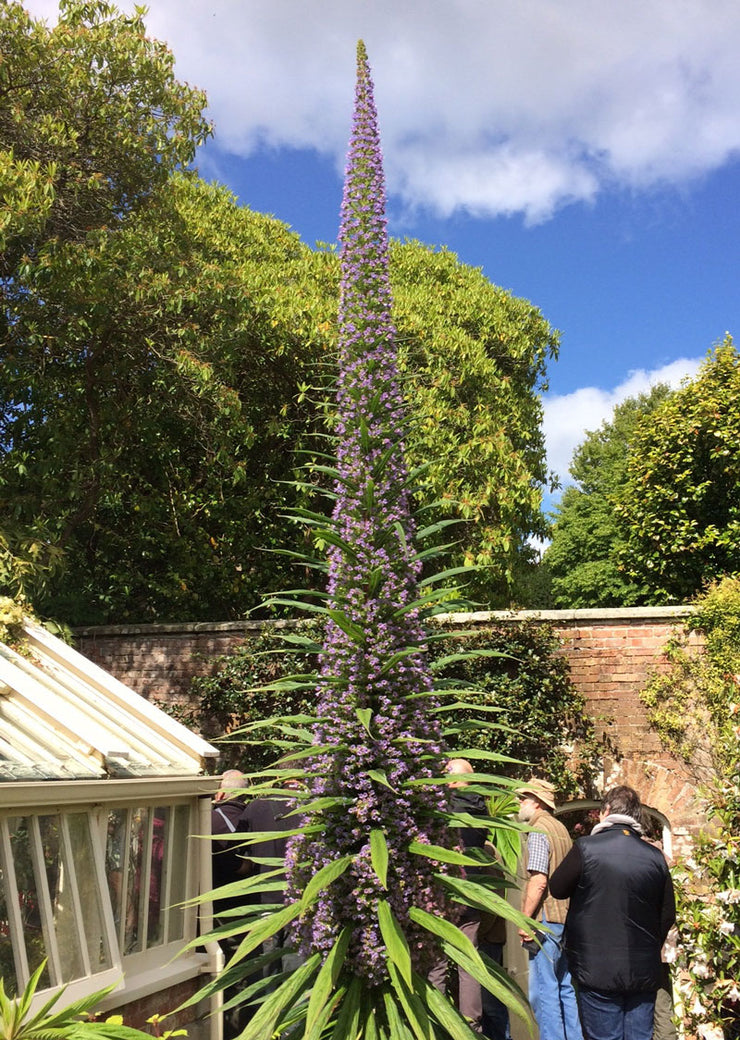recommend me something which is so beautiful, so exotic, to go grow there - something which will make people’s jaws drop.
The problem will be getting anything established because of the heat, so very late summer into autumn would be the time to plant. I also do not beleive that anything is "jaw-dropping" for more than weeks during any one year, such plants simply do not exist. It also depends on what you want to pay and how long you want to wait, and how much maintenance you are willing to put into it. I also asume that it will be planted into decent soil and that the soil will not dry-out at depth, or if it does, it is going to get regular watering. Growing anything in a tub in that position is plant cruelty, if for no other reason than that roots will bake, which no normal plant likes. You do not say how large/tall the walls are. Also, just like music, beauty (how "jaw-dropping") is always in the eye/ear of the beholder.
If the walls are big enough, I'd go for climbers, or climber. None of these are self-supporting.
At the simplest level, some of the Canary ivy (Hedera canariensis) cultivars are spectacular, and are quick once established - one or two cultivars are brilliant lemon yellow and very dark green irregularly variegated. No flowers of course (or not worthy of note).
A labour of love, but variegated Trachylospermum jasminoides is one hell of a plant when in flower, and the flowers can go on for quite a time. Reasnably slow and not cheap to buy (you cn buy large palnts at huge expense).
Roses need more attention and depending on the height of the wall you'd need a climber or rambler - climbers make only 4-6 feet in height, ramblers do more height - in some varieties (e.g. Rambling Rector) 60 feet and more. They require VERY simple pruning - just completely remove older stems at the base each winter once established. Choice of variety is lmost limitless and many will flower for an age, and everyone knows about the possibilities of scent.
Wisteria is a possibility but spectacular only when in flower or when ancient, when the gnarled form of the trunk and branches can have great beauty.
If you don't want climbers, there are some very tropical borderline hardy herbaceous plants that might work, but they are THIRSTY. The tricky bit is establishing them. They will be cut down by frost but the root-stock/tuber will over-winter fine with minimal protection and not water-logged.
Some Datura species/cultivars. They vary in maximum height from about 60cm to 200cm, and higher. Some are variegated, some are shrubs/small trees rather than herbaceous.
Hedychiums. They are mostly in the 100-300cm region.
Maybe a banana - Musa or Ensete. Again they'd be cut down by the first frost, but HUGE varieties are grown by the dedicated living way north in the UK - they bury them in straw or bracken each year in late autumn and remove it in late spring.
There are also some very exotic-looking S African bulbs that would do well at the base of the wall, but truly spectacular only when in flower -
Eucomis, now available in a variety of sizes and umpteen colours, including red/broze foliage.
Crinum - leaves look similar, but flowers do not, many are scented
There are also Crinum hybrids with other genera - Amocrinum?????? (hybrid with Amarylis)
Agapanthus - endless shades of blue/blue-purple, and white, everything from 15cm to 200cm tall flower spikes.
In time, they will all offset and make a huge clump. The bulbs sit only JUST in the soil surface, maybe one third under-ground. Agapanthus is a sort of rhizome, sitting just under the soil surface.
If you really are looking for something striking all or most of the year, you are really looking at spectacular foliage, which means huge (banana, but shows nothing in winter), or variegated (loads of choice).
Anything sound/look attractive? Anything actually potentially suitable?




